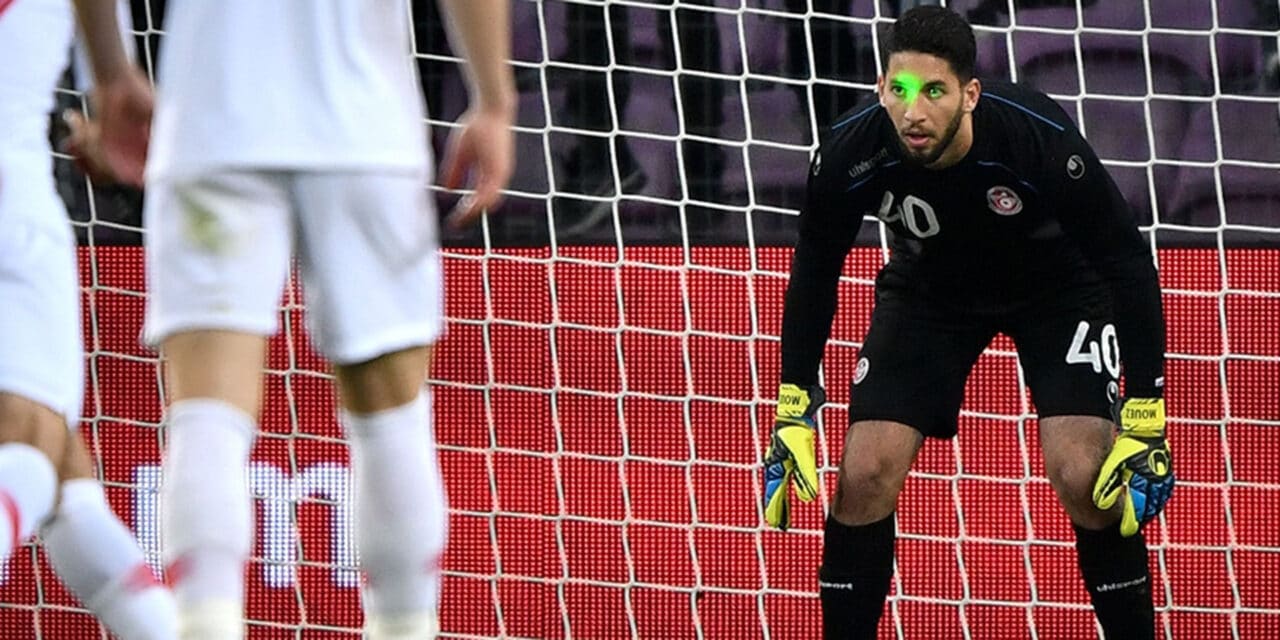STARING DOWN DANGER: A laser light shines in the eyes of Tunisia goalkeeper Mouez Hassen during an international friendly against Turkey in Geneva in 2018.
Guest opinion from Thornton Tomasetti
The use of laser pointers at professional sports events does more than distract the players and disrupt the game. It is a security and safety concern.
The latest high-profile example was caught on camera Aug. 13 when the Los Angeles Dodgers played the New York Mets at Citi Field. In the top of the ninth inning with the score tied, Dodgers first baseman Max Muncy was looking to  hit a laser up the middle. Instead, the at-bat came to a pause when a fan shined a green laser pointer in his eyes, causing the umpires to halt play for a few minutes.
hit a laser up the middle. Instead, the at-bat came to a pause when a fan shined a green laser pointer in his eyes, causing the umpires to halt play for a few minutes.

Scott Casey

Bill Edwards
The use of laser pointers at sports venues is steadily rising. Other recent incidents have occurred at international soccer and NFL venues. Some may think this is not a big deal, but lasers have the potential to damage eyesight, which is a growing concern for owners and players. The fact that fans can get lasers past security and into venues raises questions on how security screening technologies are missing these and other possible threat tools and devices.
Most public venues are using traditional magnetometers, which have sensitivity settings based on an operator’s assessment of the threat, potential risk to the event, and how quickly it needs to get attendees into the event. This is normally a venue policy decision made by the director of security or the director of operations. Standard sensitivity setting options are controlled by zones within the magnetometer and can be raised or lowered based on the level of risk and personal preference. Most security directors choose to operate their venues in the most sensitive settings in all zones, but the trade-off is long lines and wait times.
With most patrons typically entering the venue 30-45 minutes before the event starts, this creates a decision point for management that affects the fan experience.
Over the past several years, emerging technologies have attempted to change this dynamic. Advanced screening systems with high throughput capability and the use of facial authentication are slowly making their way into the market but have yet to fully reach their potential or acceptance across the board.
Going back to the incident at Citi Field, it is clear laser pointers are not breaking the threshold of technology screening sensitivities, which means either there is a gap in how the current technology supports the overall process or that venues are taking and accepting the risk.
So, what can be done? In the end, this is a venue decision on risk. The first and most important step is to conduct a threat, vulnerability, and risk assessment that looks at the realistic threats for the venue and includes the history of significant acts or events that have occurred over time. A review of the security history logs, if kept properly, will provide a pattern of life for events. This will help inform the security team on the best approach regarding technology sensitivity settings and the level of human effort associated with screening.
Security screening for an event is the first step toward creating a secure and safe environment, so it should be analyzed thoroughly. The next step is to determine what level of risk that ownership is willing to accept to support the fan experience. Security measures often detract from a patron’s enjoyment of the event but are necessary to keep everyone secure and safe. It’s a trade-off decision but one that shouldn’t be taken lightly.
The integration of technology is another important factor. Facial authentication is gaining momentum, but a thoughtful combination and integration of various types of technologies should be considered. Think in terms of screening tools, the venue video surveillance system, and hand-held devices.
Venues that understand their patrons and how they flow through the space will have analyzed and adjusted how entry control points are manned and operated. Similar events tend to generate consistent patterns; therefore, establishing the entry control points by leveraging this information will benefit the venue.
Another option for venues is offering known populations, including season ticket holders or patrons in a VIP status, special options that will speed their entry. Additionally, establishing a dedicated staff and player entrance will support the overall event.
It is imperative to always think in terms of comprehensive, layered, and integrated security systems and processes. Don’t let throughput consideration totally drive your decision-making process. Find ways to support faster throughput by creatively leveraging the knowledge you have of the venue and patrons. Security screening is literally the first line of defense.
Principal Bill Edwards leads Thornton Tomasetti’s Security Design & Consulting group. Scott Casey is a senior associate and operational security project leader at Thornton Tomasetti.







